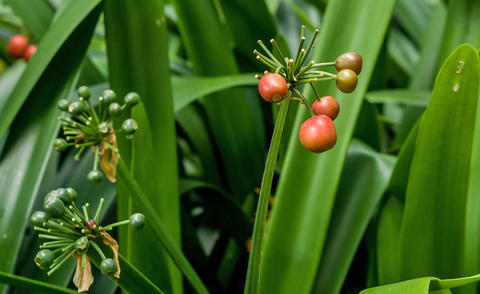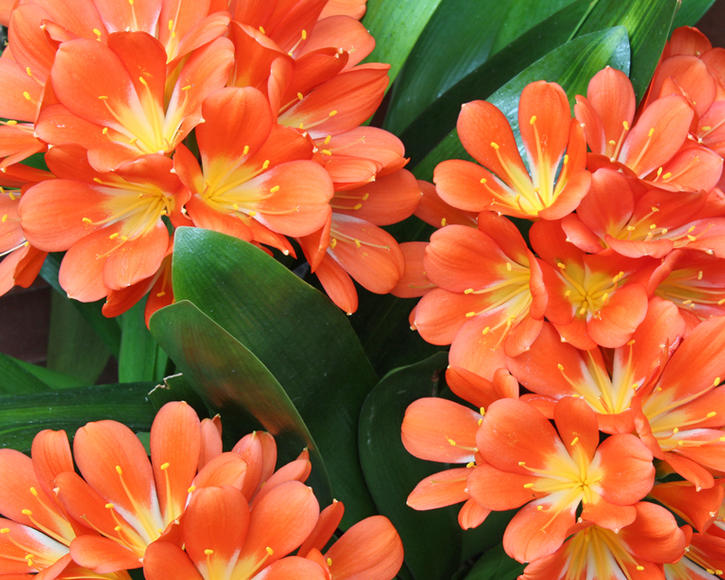Clivia miniata, Natal Lily
Despite its huge popularity, Clivia miniata is considered a difficult and lazy-flowering houseplant. With these tips you are guaranteed to make your Natal Lily flower.
Factsheet
- Growth height (from)
- from 60 cm to 70 cm
- Growth characteristics
-
- sweeping
- upright
- overhanging
- Flower color
-
- yellow
- orange
- red
- Flowering time (month)
-
- February to May
- Flower shape
-
- umbels
- Funnel
- Leaf color
-
- green
- page format
-
- full margined
- long
- sword-shaped
- Sheet properties
-
- evergreen
- Fruit color
-
- red
- Fruit shape
-
- Capsule
- Light
-
- scattered light
- Soil type
-
- loamy
- Soil Moisture
-
- fresh
- ph value
-
- weakly acidic
- Nutrient requirements
-
- nutrient-rich
- Decorative or utility value
-
- Flower Decoration
- Leaf ornaments
- picturesque growth
- Use
-
- Interior greening
- Planters
- Winter garden
- Garden style
-
- Pot garden
Clivia miniata, often also called the Natal lily, originates from the South African province of Natal. It has been kept as a cultivated plant since 1854 and spread rapidly from England. Today, it is considered one of the most popular flowering houseplants in the world. Botanically, it belongs to the Amaryllidaceae family. As with most lilies, all parts of the Natal lily are poisonous. You should therefore always wear gloves when carrying out any care measures.
The 23.62 to 27.56 inch tall Clivia miniata has long, dark-green, coarse, fleshy leaves. Instead of bulbs, it has fleshy roots from which a bulb-like trunk of leaf sheaths rise up.
At 2.36 inches wide, the sword-shaped leaves of the Natal lily are relatively broad in comparison to other Amaryllis plants, such as the amaryllis. They grow in an overhanging arch shape and give the houseplant an attractive look even outside of the flowering period.
Clivia miniata is early flowering and already opens its orange to red colored flowers from February to May. These stand on a long shaft and in umbels that are composed of up to 20 trumpet-shaped flowers.

The Natal lily infructescences consist of round capsules that turn redder with increasing maturity.
Clivia miniata do not like direct sun but do require plenty of light. They are happy in summer on the patio, in the roof garden, or on the balcony. Clivia miniata reacts somewhat moodily to location changes when it is flowering. In practice, it has proven effective to mark the pot with a point so that it can always be repositioned in the same place. Otherwise the flowers may drop.
The Natal lily requires a loamy and loose-permeable substrate that is rich in nutrients. A pH value of around 6 is recommended.
Keep the root ball evenly moist. If Clivia miniata is watered too little or too much, its leaves become wrinkled and lose their deep-green color. One-off drying out is not as bad as waterlogging. Water sparingly in the winter so that the ball is almost dry. After the winter break, the plant is watered normally again bit by bit.
From March to October, Clivia miniata should be given flower fertilizer in a one to two week rhythm.
Repotting is only necessary if the roots cover the pot surface. This occurs about every three to four years with Natal Lilies. When repotting, take care to ensure that the fleshy roots are not damaged - they are very sensitive. The pot should be around 0.79 inches wider in diameter than the previous one. It’s best to use heavy planters to prevent this very broad growing plant from falling over.
The only pruning measures required for Clivia miniata are to cut off the infructescences after flowering and - a little later - remove the dead shafts.
Hobby gardeners often complain that their Clivia miniata isn’t flowering. Clivia miniata requires a cold stimulus to form flowers. For this, a resting period of at least two months must be observed from October, during which time the plant is placed in cool temperatures between 50 and 53.6 degrees Fahrenheit.

Natal Lily varieties are unfortunately not very easy to get hold of. But it’s worth the search. Clivia miniata ‘Striata’, with its wonderful, yellow-green variegated foliage, or the yellow flowering ‘Aurea’, for example, are recommended. These varieties are also sometimes offered as varieties under the names Clivia miniata var. flava or var. citrina.
Clivia miniata forms child plants after flowering, known as plantlets. They are carefully separated from the main plant when repotting and placed individually in pots. After a few weeks in a bright location, the plantlets have formed roots. Flower soil mixed with peat and coarse sand makes suitable potting soil.
The Natal lily is hardly susceptible to any diseases. Nor does it have any serious problems with pests.

